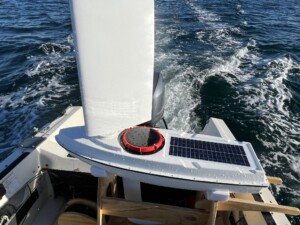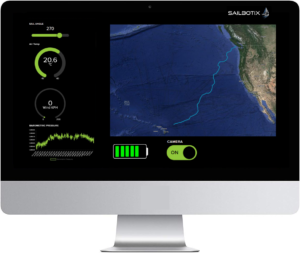Powerful, small

New technology inevitably makes its debut as large and clunky, but quickly the miniaturization process begins. It’s no different with USVs and we pride ourselves in producing the world’s smallest (and most affordable) offshore-capable Uncrewed Surface Vehicles.
The inception of Sailbotix was driven by the ambition to overcome several pervasive challenges within the USV industry, including regulatory hurdles, prohibitive costs, and issues with reliability. Larger uncrewed surface vessels often face operational difficulties due to stringent government maritime regulations. Sailbotix vessels, in contrast, are designed to be compact enough to qualify as steerable buoys (legally categorized as “flotsam”), thereby avoiding regulatory challenges.
These vessels are not only exceptionally cost-effective to produce but are also built with a focus on reliability through the principle of simplicity. The overarching mission of Sailbotix is to establish IOT networks across the ocean in a manner that is reliable, economical, and safe.
Our innovative, patent-pending autonomous sailboats serve as dynamic data-collection platforms, capable of maintaining fixed positions or navigating to specified locations. Uniquely designed for extended operations of up to six months, these vessels are built to withstand all sea states.
We offer three different models Our lowest cost boat, Wind Wanderer, is a trackable free drifter, the midsized model, Silicon Sailor, utilizes a rigid wing sail controllable through satellite. Our most advanced vessel, Hybrid Voyager, is the same as Silicon Sailor, with the addition of a thruster motor. Various sensor and tracking/software packages are available to suit your needs.
 A proprietary feature of our design is the elimination of a traditional rudder for steering. Instead, directional control is achieved by adjusting the sail’s position. The vessel will then remain balanced at different relative angles to the wind with no further actuation required for hours or days. This innovation not only mitigates a common point of failure in unmanned sailing vessels but also significantly enhances power efficiency.
A proprietary feature of our design is the elimination of a traditional rudder for steering. Instead, directional control is achieved by adjusting the sail’s position. The vessel will then remain balanced at different relative angles to the wind with no further actuation required for hours or days. This innovation not only mitigates a common point of failure in unmanned sailing vessels but also significantly enhances power efficiency.
Communication and control is achieved through LTE and satellite communications. A cloud-based dashboard allows data visualization and vessel control from anywhere in the world.

Frequently Asked Questions
Our rigid wing sails are not more efficient than standard cloth sails. So why use them? The primary reason for using them is they work more effectively with our proprietary rudderless control system. Additionally, they are more durable than cloth sails which are vulnerable to flapping in heavy storms, which significantly shortens life expectancy. The cloth sails used in Wind Wanderer are designed for heavy wear and will last for at least eight months on the ocean.
The hull, decks and sails of our boats are made with vacuum infusion technologies and are comprised of S-Glass and vinylester resin. Vinylester has almost the same mechanical properties as epoxy but is better suited for vacuum infusion. S-Glass is an exotic composite with similar strength to carbon fiber. Unlike carbon fibre, it is transparent to radio waves, so is more suitable for housing antennas within the hull and is invisible to radar.
We believe our boats are the quietest USVs in existence. Silicon Sailor, in particular, is extraordinarily quiet for a number of reasons. Since no rudder actuator is required to steer the boat, this means there are no motors running most of the time. Even during times when sail angle is being changed, the acoustic signature is minimal since an ultra-quiet motor/gear system is used. Additionally, due to the small size of the boat and composite construction, it is virtually impossible to spot on radar and hard to detect visually.
In nearshore situations frequented by recreational boaters, there is always a risk, and the vessel should be monitored from shore or with a support boat. When offshore there is almost no risk to other vessels. Our boats are 125 cm long and weigh approximately 14 kg. A direct collision with any ship or fishing boat would not even be noticed by the crew. As far as damage to the USV, most likely it would glance along the side of the ship unscathed. In the event it is damaged, foam flotation ensures the vessel does not sink.
Only sensors required for operation of the boat are included. We sell several different sensor packages depending on your needs.
The vessels are designed to operate indefinitely. The electrical system remains topped up with the solar panels, the boat is propelled by the wind, and a very robust and simple mechanical system ensures longevity. Biofouling is the factor that will ultimately cause the boats to slow down, and eventually lose steerage way. How long the boats can travel for depends on the type of antifouling paint used, and the regions it is travelling through. We estimate six months will probably be the upper limit for a continuous controlled journey. For our Wind Wanderer, free drifting boats, the vessels could potentially go for years.
The solar panel is 20 watts, and will generate about 40-100 Wh/day. While this may not seem like a lot, our vessels use under 2 Wh/day for basic electronics, sensors and communications, meaning there’s a lot left over for other uses.
Absolutely not! While these boats are inexpensive, capable, and extraordinarily reliable, there is a limit to what you can do with them. You’re not going to drag a massive power-hungry multibeam transducer out to the Grand Banks and start mowing the grass! Users need to be realistic on what can be achieved with a small, power restricted vessel, and plan tasks accordingly.
Our vessels can carry up to 4 kg (properly balanced), and a continuous power supply (via solar) of 40-100 Wh/day. A 300 Wh battery can store power and provide increased power for short periods.
The number one point of failure in sailing USVs is the rudder. The rudder is vulnerable to getting jammed or tangled in seaweed or debris. Additionally, the rudder servo (motor) is heavily worked. The simple physics of the situation is the smaller the boat is relative to the waves, the more the rudder has to move back and forth to hold course, and every servo motor has a finite life. We have completely eliminated the need for a rudder in our Silicon Sailor by balancing the rigid wing sail relative to the keel. When the angle of the sail is changed, the boat will passively sail at a different angle relative to the wind. Since the vessel is balanced, no rudder or control system is required to hold course. When winds are steady, the sail servo may not need to be moved for days.
No, Hybrid Voyager is equipped with a rudder. Since Hybrid Voyager has an auxiliary propeller system, it requires a rudder to steer when using the thrust motor. It can, however, sail without a rudder, so when sailing, the rudder can be left in the neutral position (simply acting as a skeg). This means the boat is still capable of being controlled in the event of a rudder failure and making way with ultra-low power consumption.
Wind Wanderer is a free drifting vessel meaning it simply goes straight downwind and will cross oceans following prevailing wind patterns. While it is tracked by satellite, its course cannot be changed once underway. While it can’t be steered remotely, we have a proprietary system that allows the boat to sail 90 degrees to the wind for a predetermined amount of time. This allows it to be safely launched from shore in regions where winds blow shoreward. After the vessel is well out to sea, the sail configuration is changed (a one-time deal) to then angle straight downwind. This can mitigate the necessity of launching from a crewed ship.
Our boats are not designed to be fast, and average 1-2 knots. Top speed in good conditions is about 3.5 knots.
